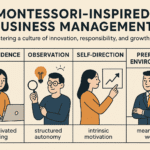
Decision-making is like being the captain of a ship in a foggy ocean – except the crew keeps yelling conflicting advice, the compass is spinning wildly, and you’re pretty sure that iceberg over there is a metaphor for your career.
AI? It’s the lighthouse guiding you through the madness.
Decision-Making: Before AI
Ah, the good ol’ days of decision-making, when your primary tools were gut instinct, a hastily Googled statistic, and a coin you kept flipping until it landed on the side you wanted.
Decision-making back then often felt like playing darts blindfolded while someone spun you in circles and shouted, “HURRY UP!”
First, there was the overwhelming information phase. You’d gather data from a thousand different sources – spreadsheets, surveys, industry reports, your second cousin’s “hot take” on Facebook – and try to make sense of it all.
“Okay, 42% of people want this. But 37% want that. And 21%… wait, is this a pie chart or a pizza order?!” Cue the headache.
Then came the analysis paralysis phase. You’d sit there staring at your options, overthinking every possible outcome.
“If I choose Option A, I might lose 10% of customers. But if I choose Option B, I might lose 15%, unless they all secretly love Option B, in which case I – oh no, I’ve gone cross-eyed.”
And of course, the panic phase. When the deadline hit and you still didn’t have an answer, you’d resort to wild guesswork or ask your team, “What feels less wrong?”
Bonus points if you decided based on whose voice was loudest in the meeting.
Decision-making back then was stressful, chaotic, and often a shot in the dark. You’d make the call, cross your fingers, and hope the fallout wasn’t too catastrophic.
“Well, that didn’t go as planned, but at least the office snacks are still popular.”
Decision-Making: After AI
Welcome to the AI era, where decision-making is no longer a terrifying game of roulette.
With AI tools on your side, making decisions feels less like gambling and more like strategizing with a crystal ball that actually works.
Step 1: Gather Data Without Losing Your Mind
AI tools like Tableau and Power BI collect, organize, and visualize data for you.
Instead of drowning in spreadsheets, you’ll get clear, colorful dashboards that show exactly what’s happening.
“Oh, so sales dipped last quarter because we ran out of avocado toast candles? Got it.”
Step 2: Analyze Like a Genius
AI tools like IBM Watson or RapidMiner dive into the data and find patterns you’d never spot on your own.
They’ll tell you what’s working, what’s not, and what might happen if you tweak your strategy.
It’s like having a digital Sherlock Holmes on your team – but without the pipe and questionable social skills.
Step 3: Predict the Future (Yes, Really)
Predictive analytics tools like BigML or Google Cloud AI simulate different scenarios and forecast outcomes.
“If we lower prices by 10%, we’ll increase sales by 25%, but only if we also improve shipping times.” Thanks, AI.
You’re like a fortune teller, but without the incense and dramatic hand gestures.
Step 4: Make Smarter, Faster Decisions
AI decision platforms like Qlik or DataRobot don’t just give you recommendations – they explain why they’re recommending them.
“Choose Option B because it has the highest ROI and the lowest chance of causing the marketing team to riot.”
Step 5: Monitor and Adjust
Once you’ve made your decision, AI tools like Looker or Sisense track performance in real time.
If things aren’t going as planned, they’ll let you know ASAP so you can pivot. “Hey, sales are down in the Midwest – maybe run a regional promo?
Also, stop ignoring Ohio.”
With AI, decision-making becomes faster, smarter, and way less stressful.
Instead of second-guessing every move, you’ll have data-backed confidence to say, “This is the right call – and here’s why.”
How to Teach Yourself About AI-Enhanced Decision-Making
Ready to make decisions like a boss (minus the sleepless nights and existential dread)? Here’s how to dive into AI-powered decision-making tools:
- Start Small: Use tools like Google Sheets Add-ons or Excel’s AI features to experiment with basic data analysis.
- Visualize Your Data: Try platforms like Tableau or Power BI to turn raw data into easy-to-understand visuals.
- Analyze Trends: Use tools like RapidMiner or Qlik to identify patterns and trends in your data.
- Predict Outcomes: Experiment with predictive tools like BigML or Google Cloud AI to simulate potential scenarios.
- Track and Learn: Use platforms like Looker or Sisense to monitor results and refine your decision-making process.
Your 5 Step AI Knowledge Quest Action Plan
- Gather Data Smarter: Use Tableau or Power BI to visualize your data and make it digestible.
- Analyze Like a Pro: Let IBM Watson or RapidMiner uncover hidden insights in your data.
- Predict the Future: Simulate outcomes with BigML or Google Cloud AI.
- Make Data-Driven Decisions: Use AI decision platforms like Qlik or DataRobot for recommendations you can trust.
- Monitor and Adapt: Track your decisions with tools like Looker to adjust strategies as needed.
5 Creative AI Decision-Making Tips
- Ask the Right Questions: AI tools are only as good as the questions you ask. Instead of “What’s the best option?” try “What’s the most cost-effective way to increase revenue by 20%?” Specificity is key!
- Combine Data with Intuition: Use AI to crunch the numbers, but don’t ignore your gut instincts. (Unless your gut just really wants tacos. Then maybe double-check the data.)
- Include Your Team: Share AI insights with your team to foster collaboration. “Hey, the data says Option B is best. Thoughts?” You’ll look like a genius and a great leader.
- Simulate Multiple Scenarios: Use predictive tools to explore all possible outcomes. “What happens if we double the budget? What if we slash it in half?” AI gives you the answers without the risk.
- Learn from Mistakes: AI can analyze past decisions to show what worked, what didn’t, and why. Use those insights to improve over time. “Okay, maybe launching that avocado-scented cologne wasn’t our brightest idea…”
With AI in your corner, decision-making isn’t just easier – it’s smarter, sharper, and kind of fun. So go ahead, captain your metaphorical ship with confidence.
The fog is lifting, and the lighthouse is shining bright. 🌟
Go To AI Support for Various Functions
















